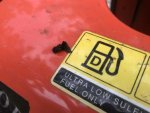Thought I’d give Idaho Wolfman a break for once and post here,...... lol.....
Glad you figured out your issue with the fuel! Can anyone tell me what the “outlet” of the inside of the tank is manufactured? I take it that it must be a bit higher than the bottom of the tank to aid in avoiding foreign particles getting into the fuel line to filter?
I have the same issue as what was originally posted here. Fuel flows strong when removing the line from the inlet side of fuel filter. (L3200). I never thought of the spraying of the inside of the tank.... going to have to give that a shot tomorrow hopefully......
Thanks again everyone for all your advice and help!
Chris
Glad you figured out your issue with the fuel! Can anyone tell me what the “outlet” of the inside of the tank is manufactured? I take it that it must be a bit higher than the bottom of the tank to aid in avoiding foreign particles getting into the fuel line to filter?
I have the same issue as what was originally posted here. Fuel flows strong when removing the line from the inlet side of fuel filter. (L3200). I never thought of the spraying of the inside of the tank.... going to have to give that a shot tomorrow hopefully......
Thanks again everyone for all your advice and help!
Chris


